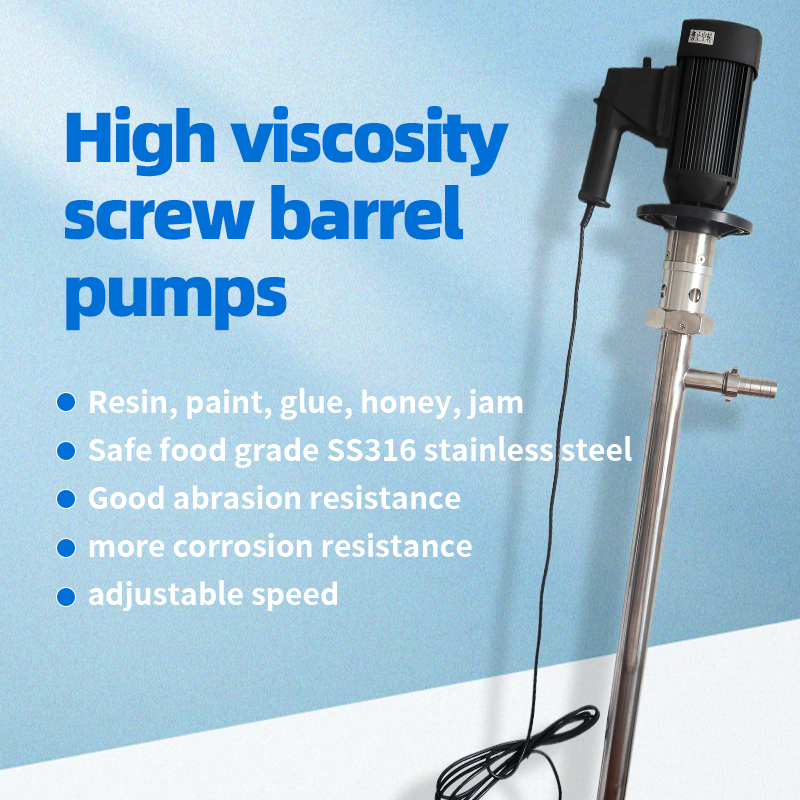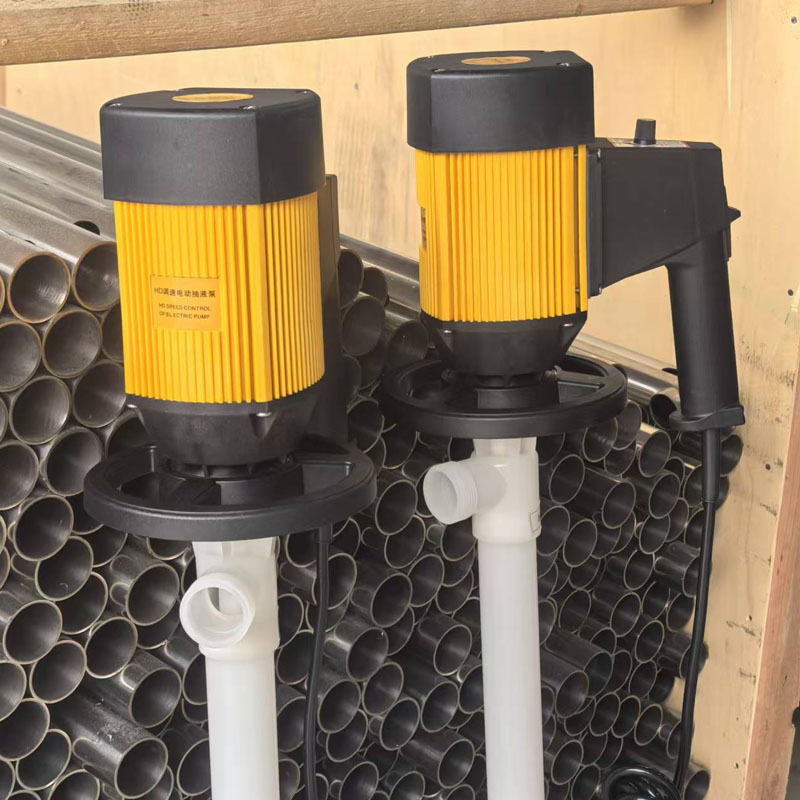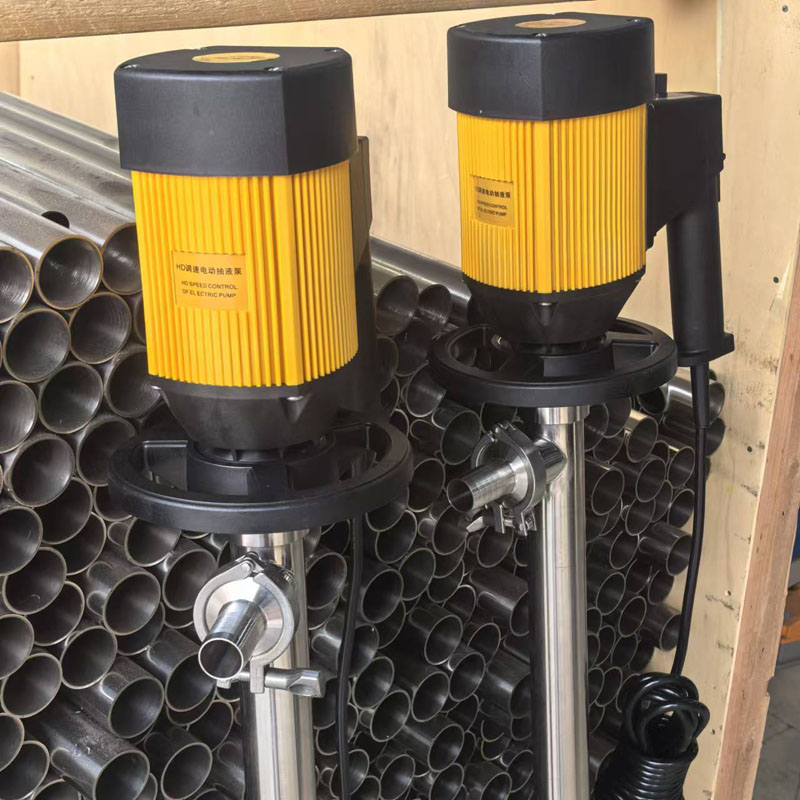Barrel pump knowledge
Sanitary screw pump use matters and maintenance
目录
Sanitary screw pumps care and maintenance
Precautions for use of sanitary screw pumps
sanitary screw pump
A sanitary screw pump (also known as a progressive cavity pump) is a type of positive displacement pump designed for hygienic applications in industries such as food & beverage, pharmaceuticals, cosmetics, and biotechnology. It ensures gentle, low-shear pumping of viscous, abrasive, or shear-sensitive fluids while maintaining high cleanliness standards.
Key Features of Sanitary Screw Pumps:
Hygienic Design:
Made from stainless steel (304 or 316L) or other FDA/EC1935-compliant materials.
Smooth, polished surfaces to prevent bacterial growth.
Easy to clean (CIP/SIP compatible).
Progressive Cavity Mechanism:
Consists of a helical rotor (screw) rotating inside a stator, creating sealed cavities that move fluid smoothly.
Provides pulsation-free, low-shear flow, ideal for delicate products like yogurt, creams, or fruit pulps.
Applications:
Food & Beverage: Pumping syrups, sauces, dairy, juices, and pastes.
Pharmaceuticals: Handling gels, ointments, and sterile fluids.
Cosmetics: Transferring lotions, shampoos, and creams.
Biotech: Gentle pumping of cell cultures and sensitive media.
Advantages:
High viscosity handling (up to 1,000,000 cP).
Self-priming and able to handle solids or abrasive particles.
Precise flow control (flow rate proportional to speed).
Reversible flow direction.
Sanitary Standards:
Complies with 3-A, EHEDG, FDA, ASME BPE.
Tri-clamp or DIN fittings for quick disassembly.
Common Manufacturers:
Zhilong
Alfa Laval
Waukesha (SPX Flow)
Fristam
Moyno (NOB)
Seepex
Maintenance Considerations:
Regular inspection of stator wear (especially with abrasive fluids).
Proper lubrication (if applicable).
Ensure seals/gaskets are food-grade and intact.
Sanitary screw pumps care and maintenance
Proper care and maintenance of sanitary screw pumps (progressive cavity pumps) are crucial to ensure longevity, efficiency, and compliance with hygiene standards in food, pharmaceutical, and cosmetic industries. Below are key maintenance practices:
1. Routine Inspection & Monitoring
Check for leaks (seals, connections, and mechanical seals).
Monitor pressure & flow rate – Sudden drops may indicate wear or blockage.
Listen for unusual noises (grinding, knocking) which may suggest rotor-stator misalignment or bearing failure.
Vibration analysis – Excessive vibration can signal misalignment or worn parts.
2. Lubrication (If Applicable)
Gearbox & bearings – Use food-grade lubricants if in contact with product.
Mechanical seals – Ensure proper lubrication (if not dry-running).
Follow the manufacturer’s lubrication schedule.
3. Stator & Rotor Maintenance
Inspect stator wear – The rubber/elastomer stator degrades over time, especially with abrasive or corrosive fluids.
Replace if swelling, cracking, or loss of elasticity is observed.
Check rotor for wear/scoring – A damaged rotor reduces efficiency and may damage the stator.
Ensure proper clearance – Excessive gap reduces pumping efficiency.
4. Seal & Gasket Maintenance
Mechanical seals – Check for leaks and replace if damaged.
Sanitary gaskets (e.g., EPDM, PTFE, silicone) – Inspect for cracks or deformation.
Ensure proper seal alignment during reassembly.
5. Cleaning (CIP/SIP)
Clean-in-Place (CIP) – Use approved detergents & sanitizers (avoid harsh chemicals that degrade elastomers).
Steam-in-Place (SIP) – If applicable, ensure temperature does not exceed stator material limits.
Disassemble for thorough cleaning if handling sticky or hardening products (e.g., chocolate, cheese).
6. Storage & Downtime Care
Flush the pump with water or a preservative fluid before long-term storage.
Store in a dry place – Avoid UV exposure (can degrade elastomers).
Rotate the rotor occasionally to prevent stator deformation.
7. Common Failure Signs & Solutions
| Issue | Possible Cause | Solution |
|---|---|---|
| Reduced flow/pressure | Worn stator, rotor wear, or blockage | Inspect & replace stator/rotor, clear blockage |
| Leakage at seals | Damaged mechanical seal or gasket | Replace seal/gasket, ensure proper tightening |
| Overheating | Dry running, misalignment, excessive speed | Check lubrication, alignment, and operating speed |
| Excessive vibration | Worn bearings, misalignment, cavitation | Inspect bearings, realign pump, check suction conditions |
8. Recommended Spare Parts
Stator (most common replacement part)
Rotor
Mechanical seals & gaskets
Bearings
Shaft couplings
Preventive Maintenance Schedule
| Task | Frequency |
|---|---|
| Visual inspection | Daily/Weekly |
| Lubrication check | Monthly |
| Stator/rotor inspection | Every 3–6 months (depends on fluid abrasiveness) |
| Full disassembly & deep clean | Annually or per CIP/SIP cycles |
Final Tips
Always use manufacturer-approved parts for replacements.
Keep maintenance records for audits and traceability.
Train operators on proper startup/shutdown procedures to avoid dry running.
By following these steps, you can maximize the lifespan and performance of your sanitary screw pump while maintaining hygiene compliance. Let me know if you need help troubleshooting a specific issue!
Precautions for use of sanitary screw pumps
To ensure safe, efficient, and compliant operation of sanitary screw pumps (progressive cavity pumps) in food, pharmaceutical, and cosmetic applications, follow these key precautions:
1. Proper Installation & Alignment
Ensure correct piping support – Avoid stress on pump flanges to prevent leaks/misalignment.
Check motor-pump alignment – Misalignment causes vibration, seal failure, and premature wear.
Use proper gaskets/seals – Must be FDA/EC1935-compliant (e.g., EPDM, PTFE, silicone).
2. Avoid Dry Running
Never operate the pump dry – Even brief dry running can damage the stator (elastomer) and mechanical seals.
Prime the pump before startup – Ensure fluid is present in the suction line.
Use run-dry protection sensors (if available) to shut down the pump if fluid is absent.
3. Control Operating Conditions
Monitor temperature – Excessive heat degrades the stator material (check max temp rating).
Limit speed (RPM) – Higher speeds increase wear; adjust per fluid viscosity.
Avoid excessive pressure – Stay within the pump’s maximum pressure rating to prevent stator blowout.
4. Handle Fluids Correctly
Check fluid compatibility – Ensure the stator material (e.g., NBR, EPDM, FKM) is resistant to the pumped fluid.
Avoid abrasive fluids without proper hardening – For slurries or abrasive media, use hardened rotors/stators.
Prevent solid buildup – For sticky products (e.g., honey, chocolate), flush the pump after use.
5. Startup & Shutdown Procedures
Startup:
Open suction valve fully.
Partially open discharge valve (to reduce initial load).
Start the pump and gradually open the discharge valve.
Check for leaks, noise, or vibration.
Shutdown:
Close discharge valve first.
Stop the pump.
Close suction valve.
Flush with water/CIP fluid if handling corrosive or hardening products.
6. Safety & Hygiene Precautions
Lockout/Tagout (LOTO) during maintenance to prevent accidental startups.
Use sanitary fittings (tri-clamp, DIN) for easy disassembly and cleaning.
Follow CIP/SIP protocols – Ensure no chemical residues degrade elastomers.
7. Common Mistakes to Avoid
| Mistake | Risk | Prevention |
|---|---|---|
| Running dry | Stator burns, seal failure | Always prime the pump |
| Over-tightening fittings | Gasket damage, leaks | Use torque wrench per specs |
| Ignoring vibrations | Bearing/rotor damage | Check alignment & mounting |
| Mixing incompatible fluids | Stator swelling/cracking | Verify chemical resistance |
8. Emergency Response
If leakage occurs: Stop immediately, isolate the pump, and replace seals/gaskets.
If pump jams: Do not force restart; inspect for blockages or stator damage.
Overheating: Shut down, check for proper lubrication and cooling.
Summary Checklist for Safe Use
✅ Verify fluid compatibility with wetted parts.
✅ Prime the pump before starting.
✅ Operate within rated pressure/temperature.
✅ Follow strict CIP/SIP procedures.
✅ Regularly inspect seals, stator, and alignment.
By adhering to these precautions, you can extend pump life, prevent contamination, and ensure smooth operation in hygienic processes. Need help with a specific application? Ask away!



